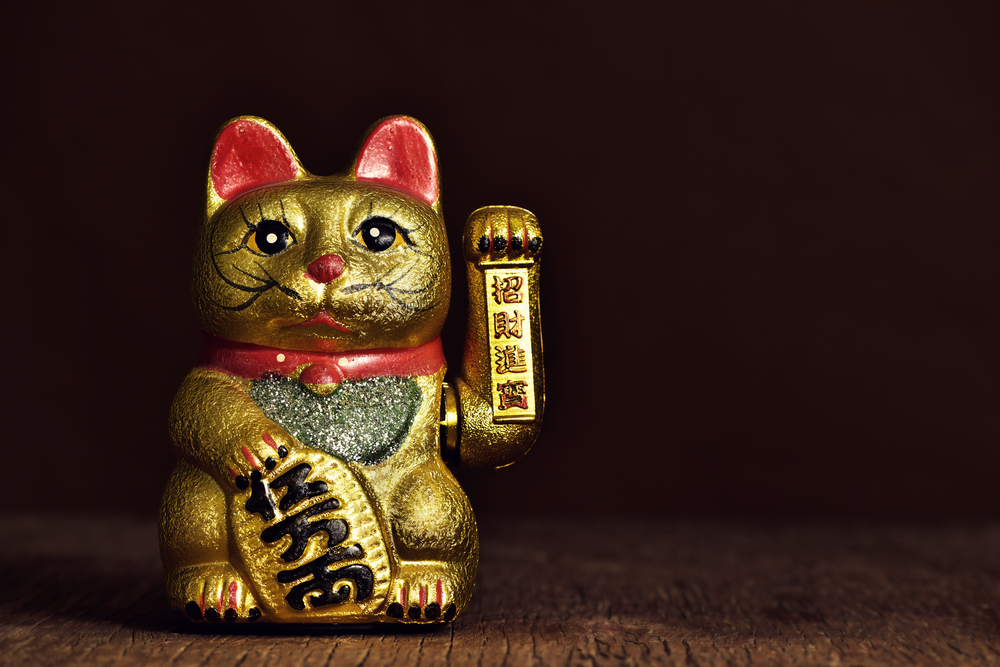
They’re everywhere: adorable little cat figurines, each raising a single paw as if to say “hello.” They sit inside Japanese and Chinese restaurants and shops all over Canada, peering at us with huge round eyes and cute smiles on their little kitty faces. They’re said to bring good luck wherever they air. But what’s the story behind these statues? They’re called “maneki neko,” which means “beckoning cat” in Japanese. And they offer a fascinating look into Japanese beliefs and culture.
A Fabulously Fortunate Feline
Where did Lucky Cat come from? It depends on who you ask. One story involves a monk who lived at the Gotokuji temple during the 1400s. The monk was of meager means, but he cared for the temple as best he could. When a stray cat wandered into the temple one day, he allowed the creature to stay. The monk adored his cat, caring for it and sharing what little food he had with it. And one day, he asked the cat to bring him good luck.
Several days later, several samurai approached the monk and explained that the cat had waved to them from the road. One of the men, Lord Naotaka of Hikone, mentioned that he’d taken shelter under a tree during a thunderstorm when he’d seen the kitty waving. As he approached the cat to get a closer look, lightning struck the tree where he’d been standing. Grateful for the cat saving his life, Lord Naotaka donated to the temple and helped it grow into a major landmark.
Another story claims that a poor merchant found a starving stray cat near his stop. Despite his own financial struggles, he took the animal in and cared for it. The cat rewarded the merchant’s kindness by sitting in front of the shop and beckoning customers inside. The merchant’s business grew, bringing him greater prosperity.
The History of Maneki Neko Figurines
SFO Museum explains that artisans first began sculpting cat figurines during the late Edo period. During this time, Japan was ruled by the Tokugawa shogunate. The Encyclopedia Britannica mentions that lower social mobility and resistance to foreign influence were common during this time. But it also brought significant economic growth, especially for merchants and tradespeople.
Located on the west bank of the Sumida River, Tokyo’s Imado region is well known for its pottery. The same kilns that produced stoneware for Japan’s dining tables began producing simple maneki neko figurines during the mid-1800s. Over time, these figurines developed design variations like the ones we see in restaurants and shops today.
Crafting maneki neko statues is still a popular art form in modern Japan. Most come from Tokoname, a coastal town about 225 miles southwest of Tokyo. There’s even a giant cat statue, Tokonyan, located on Manekineko Street.
Packed With Unique Symbolism
Today, maneki neko figurines vary in color and size. But you’ll see some common details on most of these statues. Nearly all of them sport a bib attached at the neck, painted with coins and other good luck tokens. They also hold up a single paw, but it’s not always the same paw. A raised left paw brings good fortune to a business, while right-pawed versions invite wealth into one’s home. The statues’ color variations aren’t just for aesthetics, either: White represents happiness, black drives away evil, and gold attracts wealth.
Humans have been fascinated with cats for millennia. Maybe we don’t revere them as gods as the ancient Egyptians did, but we offer space in our homes and hearts for these wonderful beings. While maneki neko figurines are adorable, the stories behind them reveal some key beliefs. Whether tangibly or not, generosity can bring rewards to those who practice it.


